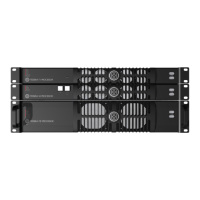
Do you have a question about the Brompton Technology Tessera M2 and is the answer not in the manual?
| Brand | Brompton Technology |
|---|---|
| Model | Tessera M2 |
| Category | Media Converter |
| Language | English |
Details copyright, trademarks, document changes, and manual scope.
Provides an overview of the Tessera system components and purpose.
Outlines safety precautions and handling guidelines for the processor unit.
Describes the Tessera system's architecture and connectivity.
Illustrates a typical system setup for the Tessera processors.
Covers the front and rear panels, including status LEDs and connections.
Covers the front and rear panels, including status LEDs and connections.
Covers the front panel, status LEDs, and remote connection options.
Guides users through the initial steps of setting up the Tessera system.
Explains how to create a new project using the New Project Wizard.
Details the process of connecting LED fixtures to the processor.
Configure processor name, IP address, subnet mask, and gateway.
Options for managing fixture firmware and internal storage.
Manage preferences, auto-load, canvas settings, and crash management.
View processor status, software versions, and license information.
Covers creating, opening, importing, and deleting projects.
Details cabling, connection guidelines, and adding fixtures from network.
Explains fixture recognition, swapping, topology changes, and mapping options.
Covers interacting with the canvas, selecting, grouping, and moving fixtures.
Discusses device properties, beacon, test patterns, and various canvas/edit modes.
Describes SDI and DVI input capabilities for Tessera processors.
Explains how to adjust video input size and position using Viewport and Active Area.
Details controls for Black Level, Contrast, Hue, Saturation, RGB Shadow/Highlight.
Introduces histograms as a tool for analyzing and adjusting input colour.
Learn to crossfade between inputs and use built-in test patterns for verification.
Adjusts overall light output using Intensity Gain and Brightness sliders.
Covers RGB Gain, Colour Temperature, Gamma, and colour overrides.
Explains how presets store settings for quick recall of parameters and positions.
Guides on recording, modifying presets and using them for input crossfading.
Explains using DMX or Art-Net for remote control of parameters.
Guides on setting up DMX or Art-Net protocols for processor control.
Details assigning controls to groups/inputs and managing min/max values.
Manages network load, bit depth, and pixel support affected by rotation/interpolation.
Explains fixture interpolation and how to import custom fixture definitions.
Configures synchronization, manages video delay, and uses test patterns/beacon for diagnostics.
Details the functionality of the front panel Black and Freeze buttons on the S4.
Guides for installing Tessera Remote on Mac OS X and Windows PCs.
Details setting IP addresses for Windows and Mac to connect to processors.
Covers connecting, managing settings, disconnecting, and using the offline editor.
Explains controlling multiple processors and using the Tessera Control application.
Explains OSCA for adjustments and options for displaying colours and video.
Details how to perform seam and colour adjustments using OSCA.
Lists useful keyboard shortcuts for navigating and performing OSCA tasks.
Provides a list of global and canvas-specific keyboard shortcuts.
Lists supported video resolutions and frame rates for the Tessera M2 processor.
Outlines the product warranty period, conditions, and exclusions.
An alphabetical index of topics covered in the manual for quick reference.